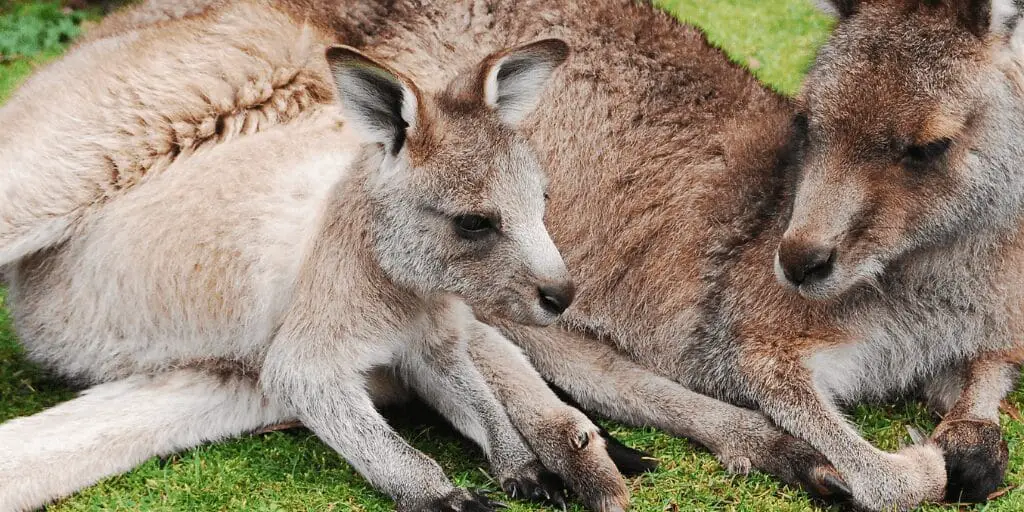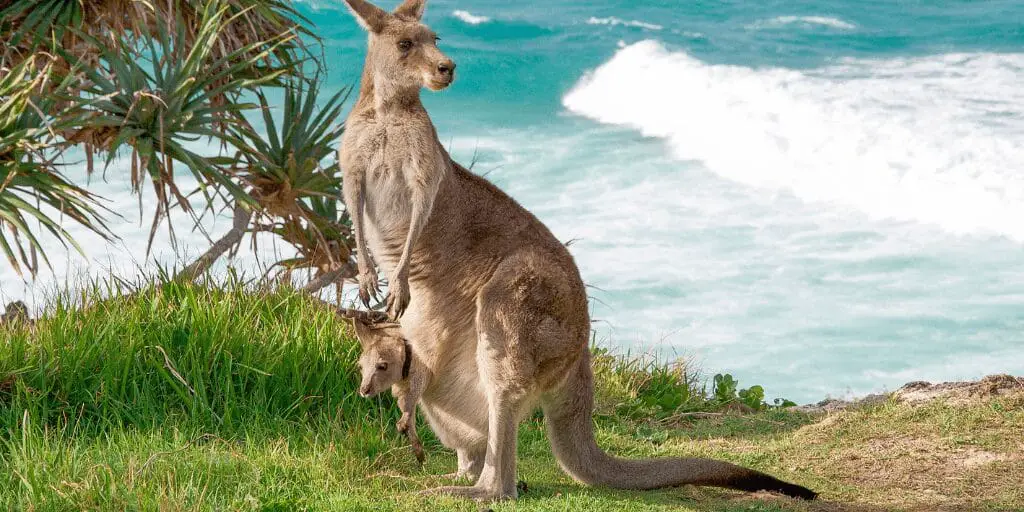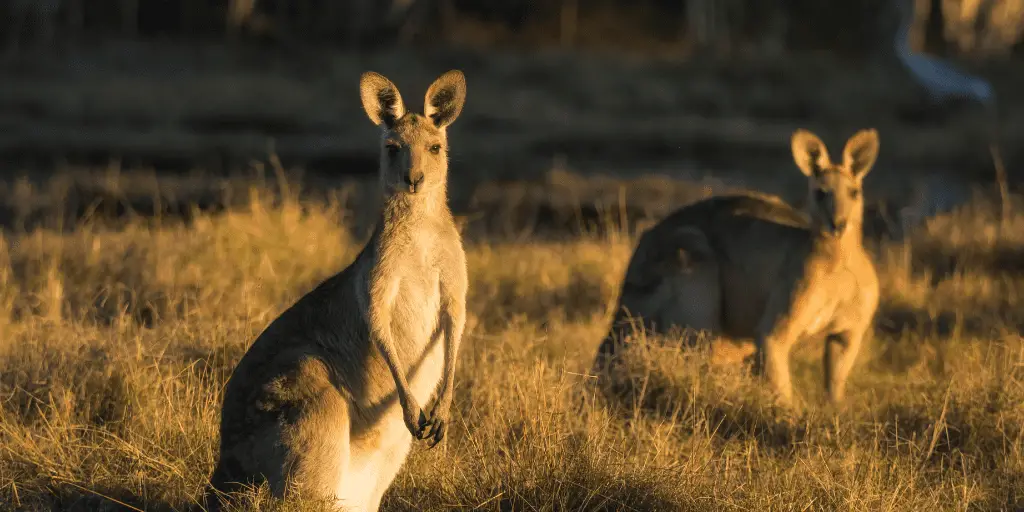Curious about the fascinating world of kangaroos? These iconic marsupials have charmed the globe with their unique traits and quirky behaviors. But diving into their universe isn’t always a leap of joy.
A complex landscape can often seem overwhelming when trying to figure out what kangaroo species are, their habitats, and their challenges.
Ever wondered about the difference between a kangaroo and a wallaby? Want to explore the mysteries of their incredible pouches? Or maybe, just maybe, you’re pondering over their unusual locomotion that defies the norms of other mammals.
These jumping giants of Australia have captivated minds for ages, yet understanding their diverse species and habitats can be as tricky as decoding their distinct communication cues.
Fun fact: Did you know kangaroos can’t move backward? Now, buckle up if you’re keen on hopping into the world of kangaroos and discovering their secrets.
With insight into their fascinating behaviors to their ecological importance, I’ve got what you need to know about these amazing marsupials.
What is a kangaroo?
A kangaroo is a marsupial indigenous to Australia, recognized for its distinctive hopping locomotion and iconic pouch. These mammals belong to the Macropodidae family, known for their strong hind legs, large feet, and powerful tails. Kangaroos, primarily herbivores, graze on grasses, leaves, flowers, and sometimes insects.
Kangaroos are:
- The largest marsupials globally.
- Ranging from the robust red kangaroo.
- Reaching up to 7 feet in height and weighing around 200 pounds, to the diminutive musky rat-kangaroo.
- Measuring only a few inches long and weighing merely a few ounces.
Notably, female kangaroos possess a pouch on their abdomen where newborn joeys develop and nurse until they mature. These pouches, a characteristic feature, are used for protection and nourishment, showcasing the kangaroo’s unique reproductive biology.
Known for their hopping prowess, kangaroos cover vast distances using their spring-like hind legs, capable of reaching speeds up to 30 mph (48 kph).
It is their social nature that often leads them to gather in groups, fostering protection and communal care among them. Kangaroos symbolize the diversity of Australian wildlife, as well as its distinct ecological landscapes.
Biology of Kangaroos
The biology of kangaroos encompasses their unique physiology, life cycle, and fascinating adaptations. From their iconic hopping movement to their reproductive methods and social structures, exploring the biology of marsupials reveals fascinating traits and behaviors.
Life Span
A kangaroo typically lives between 8 to 23 years in the wild. This duration varies based on several factors, including species, environmental conditions, and predation risks. Factors like food availability, habitat, and the individual’s health play significant roles in determining a kangaroo’s life expectancy.
Baby Kangaroos

- Development in the Pouch: Kangaroo joeys are born at a very early stage of development, resembling tiny newborns. After birth, they crawl into their mother’s pouch, continuing to grow and develop for several months.
- Pouch Life: Joeys spend a significant part of their early life inside their mother’s pouch. This secure space provides protection and a nurturing environment for their growth, allowing them to feed from their mother’s milk and gradually mature.
- Nursing and Care: The mother kangaroo provides highly specialized care for her joeys. She can simultaneously nurse two joeys of different ages, providing each with milk tailored to their specific needs.
- Pouch Cleanliness: Despite the joeys urinating and defecating inside the pouch, the mother kangaroo maintains cleanliness by using her tongue to clean the pouch, ensuring a hygienic environment for the growing young.
- Pouch Exit: As the joey grows and becomes more independent, it gradually ventures out of the pouch, returning intermittently for further nurturing until it’s ready to fully explore the world on its own.
Physical Traits
In terms of physical characteristics, it is fascinating to compare the red and grey kangaroos. They differ significantly in the following ways:
Red kangaroos (Macropus rufus) are generally the largest among kangaroo species, boasting vibrant red-brown fur. Males are notably robust and powerful, while females tend to be smaller and lighter in coloration.
In contrast, grey kangaroos, like the eastern (Macropus Giganteus) and western (Macropus fuliginosus) species, exhibit a softer greyish-brown hue with subtle variations. Grey kangaroos often prefer forested areas, while red kangaroos dominate open plains.
Regarding their physical prowess, kangaroos possess incredible jumping abilities. These marsupials can leap impressive distances, with red kangaroos capable of jumping as high as 10 feet and spanning lengths up to 25 feet in a single bound.
Their exceptional leg strength enables these astounding feats, making their agility and speed unparalleled.
Diet & Digestion

It’s fascinating to discover kangaroos’ eating preferences and digestive processes. Kangaroos are strict herbivores, living exclusively off of plants and vegetation.
Their food choices encompass a wide range of plant-based options, including grasses, leaves, shrubs, ferns, flowers, moss, and fungi, depending on the species and habitat.
These marsupials have a unique digestive system, much like other herbivores, involving a process known as “hindgut fermentation.” After ingesting plant material, kangaroos initially digest their food in their stomachs before the partially digested food enters their intestines.
Here, the breakdown continues with the assistance of specialized microorganisms present in their hindgut. This fermentation process helps extract nutrients from the fibrous plant material, ensuring optimal digestion and absorption of essential nutrients.
Their ability to regurgitate food (a process known as “cud-chewing” or “foregut fermentation”) aids in further breaking down tough plant matter.
Kangaroos, like cattle, regurgitate and rechew food to enhance the digestion of fibrous plant material, contributing to their efficient nutrient extraction from a predominantly plant-based diet.
Strength & Capabilities

The kangaroo exhibits considerable physical strength, especially in its hind legs, which are incredibly powerful and designed to carry it for vast distances.
They’re known to cover impressive ground in a single leap, reaching speeds of up to 30 miles per hour (48 kilometers per hour). The question of whether kangaroos can jump backward is a curious one – interestingly, these marsupials are not physiologically equipped to hop in reverse.
Contrary to popular belief, kangaroos are adept swimmers when necessary. Despite their proficiency in hopping, they can use their limbs for swimming, especially in dire situations, to evade predators or cross bodies of water.
Their front limbs come into play, propelling them forward, while their muscular tails act as stabilizers, showcasing their unexpected aquatic capabilities. This adaptability further highlights the versatile nature of these fascinating creatures.
Behavior & Ecology
The behavior and ecology of kangaroos encompass a wide range of social dynamics and environmental adaptations. These marsupials exhibit unique behavioral patterns within their respective habitats.
Living predominantly in groups known as “mobs,” kangaroos establish social hierarchies and engage in cooperative behaviors.
Understanding the behavior and ecology of kangaroos sheds light on their social structures, communication methods, dietary habits, and the intricate balance they maintain within their habitats.
Intellect

In considering the intellect of kangaroos, it’s essential to acknowledge their cognitive capacities within the animal kingdom. While kangaroos may not exhibit intelligence in ways akin to certain primates or dolphins, they demonstrate considerable intelligence relative to their needs.
These marsupials showcase an impressive ability to adapt to their environments, displaying complex social behaviors and problem-solving skills in various situations.
Kangaroos exhibit intelligence through their social structures and communication methods. They live in groups, or “mobs,” where they establish hierarchies, communicate through vocalizations, and exhibit cooperative behaviors, suggesting a level of social cognition.
Additionally, these creatures display adaptability in navigating their surroundings, identifying food sources, and recognizing potential threats, showcasing their cognitive abilities within their ecosystem.
While their intellect may not match that of some highly intelligent species, their survival strategies and social interactions reveal a level of intelligence suited to their environment.
Social Behavior
The social behavior of kangaroos unveils fascinating aspects of their interactions within group dynamics. These marsupials, often found in groups referred to as “mobs” or “herds,” engage in various forms of social behavior to establish hierarchy, maintain order, and communicate with one another.
Among their notable behaviors is boxing, a display primarily seen in male kangaroos. This behavior isn’t always aggressive but is often used to establish dominance or resolve disputes within the group.
Understanding kangaroos’ social behavior reveals a complex communication system involving vocalizations, body language, and occasional physical confrontations.
The hierarchical structure within kangaroo groups plays a pivotal role in their social interactions, ensuring order and cooperation among members. These behaviors offer insights into these fascinating marsupials’ social intricacies and adaptive strategies.
Habitat & Range

The habitat and range of kangaroos encompass diverse landscapes across Australia, ranging from open plains to woodlands and forests.
This adaptable species showcases variations in behavior and ecology across different environments. Exploring these habitats sheds light on their ability to thrive in various climates and terrains, including the unique adaptations that enable their survival.
Behavior & Ecology Of The Western Gray Kangaroo and Can Kangaroos Survive In Cold Weather are fascinating aspects to delve into, revealing kangaroos’ specific characteristics, behavioral patterns, and adaptive strategies in varying environmental conditions.
This exploration will highlight the Western Gray Kangaroos behavioral intricacies and the remarkable ways kangaroos adapt to colder climates, providing insights into their resilience and survival mechanisms in challenging habitats.
Conservation Status
The conservation status of kangaroos reflects a mix of challenges and successes in preserving these iconic Australian marsupials.
From an overview perspective, kangaroos, especially the more common species like the Red Kangaroo and the Eastern Gray Kangaroo, are designated as “Least Concern” by the International Union for Conservation of Nature (IUCN) due to their stable population numbers and widespread distribution.
Kangaroo populations, particularly the Eastern Gray Kangaroo, remain relatively stable, with estimates suggesting their numbers range from several million to upwards of 42 million individuals in Australia. However, despite their abundant status, kangaroos face various threats in their natural environment.
One of the common questions regarding kangaroos revolves around their predators and their overall status concerning endangerment.
Delving into these aspects, we’ll explore the predators that pose a threat to kangaroos and address the prevalent query about their endangerment, discussing their conservation status and habitat challenges.
Relationship with Humans

Kangaroos have a long history of interaction with humans, marked by various forms of coexistence, challenges, and occasionally conflicting interests.
This section will explore the multifaceted relationship between kangaroos and humans, covering aspects such as historical significance, human impact on kangaroo populations, the use of kangaroos in various human activities, and the challenges posed by human encroachment on kangaroo habitats.
Culinary
Australians have integrated kangaroo meat into their diet for decades. This lean, protein-rich meat is widely available in supermarkets across the country and is considered one of the healthier options among red meats due to its low-fat content.
Notably, kangaroo meat is abundant in conjugated linoleic acid (CLA), offering added health benefits.
Indigenous Australians have a longstanding tradition of hunting kangaroos for their meat, a practice that dates back thousands of years. While initially traded for pet food purposes in the 1950s, the consumption of kangaroo meat for human consumption was officially legalized in 1980, gaining popularity in various culinary dishes.
This versatile meat can be used in diverse recipes like burgers, sausages, casseroles, and meatballs. However, caution is advised as overcooking may lead to quick dryness due to its low-fat content.
Interestingly, the consumption of kangaroo meat also serves an ecological purpose. Licensed hunting of kangaroos is permitted in Australia as a means of population control.
This practice is regulated, requiring individuals to obtain a license before hunting or consuming kangaroo meat.
Defense
Generally known for their gentle disposition, Kangaroos can become aggressive if they feel provoked or perceive a threat, especially when protecting their young. Equipped with powerful hind legs and sharp claws, they can pose a danger when provoked, potentially inflicting severe harm.
Notably, humans are more often a threat to kangaroos than vice versa. Hunting and vehicle accidents are significant hazards for these creatures, contributing to heightened aggression when they sense danger.
While such confrontations with humans are rare, caution is advisable in their presence. Moreover, kangaroos are a protected species in Australia.
Although there are provisions for licensed hunting in specific scenarios where kangaroos are considered pests, animal cruelty laws remain in effect. Causing undue harm to kangaroos is illegal, reflecting the country’s commitment to animal welfare.
While kangaroos attacking humans or dogs are rare, they possess the physical capability to injure or kill seriously. Kangaroos’ strong hind legs can deliver powerful kicks, potentially causing severe harm.
Documented cases also indicate that kangaroos, in defense or when feeling threatened, may harm dogs by grabbing them with their front legs and using their hind claws to cause fatal injuries.
Regarding self-defense or encountering a threatening situation with a kangaroo, different legal responses may apply based on regional animal cruelty laws. However, inflicting harm on kangaroos without justification remains illegal across Australia.
Reproduction & Offspring

Kangaroos have a fascinating reproductive process that centers around their distinctive pouch. Females, also known as does or flyers, possess a forward-opening pouch where their offspring, known as joeys, develop and nurse after birth.
The female kangaroo can nurture different joeys simultaneously: one in the pouch, one suckling, and another in a state of embryonic diapause.
Gestation & Birth
Kangaroos, like many marsupials, have a unique reproductive anatomy. Female kangaroos possess three reproductive openings: two for fertilization to enter and one for giving birth.
They have two uteri and two vaginas, which converge into a single birth canal. During mating, a male kangaroo may use either of the two vaginal openings to inseminate the female.
The gestation period of a kangaroo is relatively short, lasting around 28 to 38 days. After this period, the tiny, underdeveloped joey is born about the size of a jellybean.
Unlike placental mammals, kangaroos give birth to extremely underdeveloped young that continue their growth and development within the mother’s pouch, where they latch onto a nipple and continue to develop and grow for several months.
Raising Young
Transitioning to the upbringing of their young, female kangaroos have pouches designed to nurture their newborns.
The interior of a kangaroo pouch is soft and cushioned, lined with fur that provides warmth and protection for the developing joey. Additionally, the pouch contains mammary glands that produce milk for the joey’s nourishment.
Contrary to females, male kangaroos do not possess pouches. Only female kangaroos have these specialized anatomical structures intended for carrying and raising their offspring. The pouch serves as a safe haven for the young joeys to continue growing and developing after birth.
FAQs
What are five interesting facts about kangaroos?
Kangaroos, hopping champs, reach 35 mph, leaping 25 feet. Their strong tails aid balance and function as a fifth limb. They’re predominantly left-pawed and reside in social groups called mobs. Joeys, as tiny as jelly babies, mature in their mother’s pouch.
Are kangaroos only in Australia?
Yes, kangaroos are primarily found in Australia and New Guinea. Australia’s population within commercial harvest areas was estimated at 42.8 million in 2019, down from 53.2 million in 2013.
Do kangaroos eat fruit?
Kangaroos are primarily herbivores, consuming native Australian plants like grasses, flowering plants, mushrooms, ferns, and leaves. While their diet mainly consists of fresh grass, they occasionally eat fruits and other vegetation.
What family is a kangaroo?
Kangaroos belong to the family Macropodidae, derived from the Latin ‘big foot,’ referring to their large hind feet. They are the largest animals in the Macropus genus within the Macropodidae family.
What is a kangaroo baby called?
A kangaroo baby is called a joey. After a gestation period of up to 34 days, the jelly bean-sized newborn kangaroo climbs through its mother’s fur to reach her pouch, where it continues to develop.
Conclusion
Kangaroos, iconic marsupials of Australia and New Guinea, are famed for their unique traits. These hopping champions reach astonishing speeds of 35 mph, aided by their muscular tails acting as a fifth limb.
They form social groups known as mobs, showcasing distinct left-handed preferences for various activities. Among the many intriguing facts, newborns, called joeys, enter the world highly underdeveloped, resembling tiny jelly beans as they embark on their journey into their mother’s pouch.
Primarily herbivorous, kangaroos feed on native Australian plants such as grasses, flowers, ferns, and leaves, although they occasionally consume fruits.
Belonging to the Macropodidae family, they are the largest animals in the Macropus genus and are a prominent part of Australian wildlife.
While predominantly found in Australia, their population has fluctuated over the years, estimated at around 42.8 million in commercial harvest areas in 2019. These creatures have been captivated by their distinctive behaviors, social structures, and environment adaptability.
